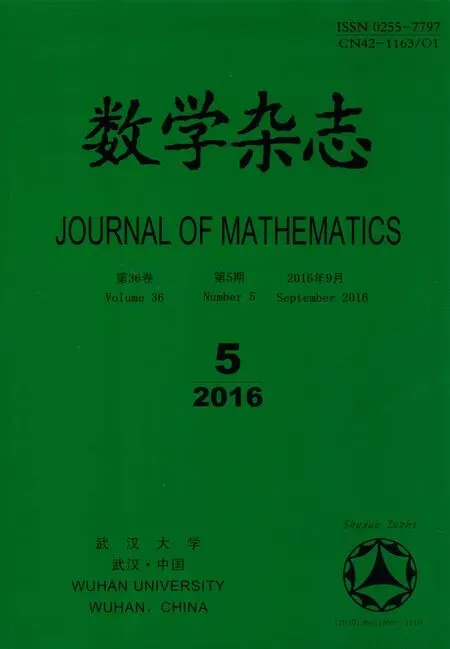THE MINIMAL SOLUTION OF A SPECIAL ANTICIPATED BACKWARD STOCHASTIC DIFFERENTIAL EQUATION
TU Shu-heng,LIAO Jun-jun
(1.School of Science,Henan University of Technology,Zhengzhou 450002,China)
(2.School of Mathematics and Statistics,Huazhong University of Science and Technology,Wuhan 430074,China)
THE MINIMAL SOLUTION OF A SPECIAL ANTICIPATED BACKWARD STOCHASTIC DIFFERENTIAL EQUATION
TU Shu-heng1,LIAO Jun-jun2
(1.School of Science,Henan University of Technology,Zhengzhou 450002,China)
(2.School of Mathematics and Statistics,Huazhong University of Science and Technology,Wuhan 430074,China)
In this paper,we study the problem of a minimal solution to a special class of anticipated backward stochastic differential equation.When the generator is continuous and satisfying a similar linear growth condition,we prove the existence of minimal solutions.Here,our hypotheses are weaker than the before papers,however,we obtain a better lemma and the same result.
anticipated backward stochastic differential equations;minimal solution;comparison theorem
2010 MR Subject Classification:60H99;60G99
Document code:AArticle ID:0255-7797(2016)05-0940-09
1 Introduction
The notions of non-linear backward stochastic differential equations(BSDEs)were introduced by Pardoux and Peng[11].A solution of this equation,associated with a terminal value ξ and a generator or coefficient f(t,ω,y,z),is a couple of adapted stochastic processes (Y(t),Z(t)){t∈[0,T]}such that

where W is a d-dimensional standard Brownian motion.This type of nonlinear backward stochastic differential equations were first studied by Pardoux and Peng in[11],and they established the existenceness and uniqueness of adapted solution under the global Lipschitz condition.Since then,many people try to weaken the conditions of generators to get the same results and study some different forms of BSDEs.For examples,Aman and Nz'i[1]studied BSDEs with oblique reflection and local Lipschitz.Bahlali[2]studied backwardstochastic differential equations with locally Lipschitz coefficients.Situ[9]and Royer[10]studied BSDEs with jumps.It is now well-known that BSDEs provide a useful framework for formulating a lot of mathematical problems such as used in financial mathematics,optimal control,stochastic games and partial differential equations(see[12-14]).Based on the above applications,specially in the field of finance,and optimal control,recently,a new type of BSDEs,called anticipated BSDEs(ABSDEs),were introduced by Peng and Yang[4]as the following

where θ(·):[0,T]→R+,ϑ(·):[0,T]→R+are continuous functions and satisfy that (i)there exists a constant K≥0 such that for each t∈[0,T],

(ii)there exists a constant L≥0 such that for each t∈[0,T]and each nonnegative integrable function g(·),

Under global Lipschitz conditions,Peng and Yang proved the existencenee and uniqueness of solution(see Theorem 4.2 in[4]).
For anticipated BSDEs,we mention that the generator includes not only the values of solutions of presents but also the future.So ABSDEs may be used in finance.From Theorem 2.1 in[4],we know that there is a duality between stochastic differential equations with delay and anticipated BSDEs which can be used in optimal control.We also mention that,following Peng and Pardoux[11],many papers were devoted to BSDEs with continuous coefficients.Especially,many scholars studied the minimal solution of BSDEs,it is refered to[3,5-8].
Motivated by the above papers,in this paper,we study a special class of 1-dimension ABSDEs as the following

2 Main Reaults
Before starting our main results,we give some necessary notions and hypotheses.
2.1 Preliminaries
Let(Ω,F,P)be a complete probability space,and let(W(t))t∈[0,T]be a d-dimensional standard Brownian motion on(Ω,F,P).Let{Ft}t∈[0,T]be the natural filtration generated by W.

·L2(FT;R){R-valued FT-measurable random variables such that E[|ξ|2]<∞};

We also need the following assumptions.
(H1)Assume that for all t∈[0,T],g(t,ω,y,z,µ):[0,T]×Ω×R×Rd×L2(Fr;R)→L2(Ft;R),where r∈[t,T+K],and g satisfies the following conditions



moreover,u1(t)≤u1(t+θ(t)),θ(t)satisfies(i)and(ii).

Lemma 2.1 Set

then gn(t,y,z,µ(r))has the following properties.
(a)Linear growth:for any t∈[0,T],y∈R,z∈Rd,µ(·)∈L2(Fr;R),r∈[t,T+K],we have

(b)Monotone property in n:for any t∈[0,T],y∈R,z∈Rd,µ(·)∈L2(Fr;R),r∈[t,T+K],gn(t,y,z,µ(r))≤gn+1(t,y,z,µ(r))≤g(t,y,z,µ(r)),and gn(t,y,z,·)is increasing.
(c)Lipschitz condition:for any t∈[0,T],y,y'∈R,z,z'∈Rd,µ(·),µ'(·)∈L2(Fr;R),r∈[t,T+K],|gn(t,y,z,µ(r))-gn(t,y',z',µ'(r))|≤u1(t)|y-y'|+u2(t)|z-z'|+u1(t)EFt|µ(r)-µ'(r)|.


Proof We use the similar method as used in[3,6]to prove(a),(b)and(c)are obvious. We only need to prove(d).By the definition of infimum,for each n∈N,n>1,there exist un∈R,qn∈Rd,νn∈L2(Ft;R),r∈[t,T+K],such that

For the above proof,we apply the triangle inequality a±-b±≤(a-b)±and a-=(-a)+. Thus we have

Since E[|EFt(µn(r))-|2]≤E[EFt|(µn(r))|2]≤E|µn(r)|2<∞,then when n∈N,n>1,we derive


therefore

For an appropriate A>0,there exists a N>0,such that for any n>N,

and

Then

By the above inequality,we know{EFt(µn(r)-νn(r))+;n∈N,n>1}is bounded in L2(Ft;R),with(2.4),we get



Since g is continuous in L2(F;R),we have

From assumption(H3),we obtain(t,yn,zn,µn(r))=g(t,y,z,µ(r)).
Consider the following equations

where l(t,y,z,µ(r))=C(ft+|y|+|z|+EFt(µ(r))-),by the comparison theorem in[4],for any t∈[0,T+K],n≥m,m,n∈N,U(t)≥Yn(t)≥Ym(t)a.e..
Before giving our main result,we give the following lemma.


Thus by(H1)-(H3),(i),(ii)in introduction and Lemma 2.1(b),Young's inequality,Fubini's lemma,(a+b+c)2≤C(a2+b2+c2),H¨older's inequality,we have



By Gronwall's lemma,we obtain

Thus



Theorem 2.3(Minimal-solution theorem)Under assumptions(H1)-(H3),(i),(ii),equation(1.2)has a minimal solution,that is ifY'is another solution of equation(1.2). Then for any given terminal value ξ(·)∈(T,T+K;R),we have



By Lemma 2.1,Lemma 2.2,we have

Thus


Furthermore,there exists a subsequence of{n},which we still denote this subsequence by {n}such that

By the linear growth,we get

while

Thus

Using the similar method,we get

Controled convergence theorem leads to

By BDG inequality,we have

Thus there exists a subsequence,which we still denote by{n}such that

Then(Y,Z)is a solution of equation(1.2).Now,we are going to prove Y is a minimal solution of equation(1.2).Assume(Y',Z')is another solution of equation(1.2),by the comparison theorem in[4],we have Y(t)≤Y'(t)a.e.for any t∈[0,T+K].The proof is completed.
References
[1]Aman A,N'zi M.Backward stochastic differential equations with oblique reflection and local Lipschitz drift[J].J.Appl.Math.Stoch.Anal.,2003,16:295-309.
[2]Bahlali K.Backward stochastic differential equations with locally Lipschitz coefficient[J].Comptes Rendus de l'Acad´emie des Sci.-Ser.I-Math.,2001,333:481-486.
[3]Lepeltier J,Martin J.Backward stochastic differential equations with continuous coeffcients[J].Stat. Prob.Lett.,1997,32:425-430.
[4]Peng Shige,Yang Zhe.Anticipated backward stochastic differential euquations[J].Ann.Prob.,2009,37,877-902.
[5]Hamad`ene S.Multi-dimensional BSDE with uniformly continuous coefficients[J].Bernoulli,2003,9:571-534.
[6]Fan Shengjun,Jiang Long.Existence and uniqueness result for a backward stochastic differential equation whose generator is Lipschitz continuous in y and uniformly continuous in z[J].J.Appl. Math.Comput.,2011,36(1):1-10.
[7]Fan Shengjun,Ma Ming Jiang,Song Xing.On the levi type theorem for minimal solutions of bsde with continuous coefficients E[J].J.Math.,2011,31(2):245-250.
[8]Jia Guangyan.Some uniqueness results for one-dimensional BSDEs with uniformly continuous coefficients[J].Stat.Prob.Lett.,2009,79(4):436-441.
[9]Situ R.On solutions of backward stochastic differential equations with jumps and applications[J]. Stoch.Proc.Appl.,1997,66(2):209-236.
[10]Royer M.Backward stochastic differential equations with jumps and related non-linear expectations[J].Stoch.Proc.Appl.,1997,66:209-236.
[11]Pardoux E,Peng Shige.Adapted solution of backward stochastic differential equation[J].Syst.Cont. Lett.,1990,4:55-61.
[12]Peng Shige.Backward stochastic differential equation and exact controllability of stochastic control systems[J].Prog.Nat.Sci.,1994,4(3):274-284.
[13]Peng Shige.Nonlinear expectations,nonlinear evaluations and risk measures.In stochastic methods in Finance[M].Berlin:Lecture Notes Math.Springer,2004.
[14]Peng Shige,Xu Mingyu.Reflected BSDE with a constraint and its applications in an incomplete market[J].Bernoulli,2010,16(3):614-640.
一类特殊的延迟倒向随机微分方程的最小解
凃淑恒1,廖俊俊2
(1.河南工业大学理学院,河南郑州450002)
(2.华中科技大学数学与统计学院,湖北武汉430074)
本文研究一类特殊的延迟倒向随机微分方程最小解的相关问题.当假设生成子满足连续性假设和类似线性增长条件时,证明了最小解的存在性.本文推广了最小解存在的一般假设条件,这里假设要弱于之前的文献,然而本文得到了更好的引理,并且得到了相同的结论.
延迟倒向随机微分方程;最小解;比较定理
MR(2010)主题分类号:60H99;60G99O211.63
date:2014-09-05Accepted date:2014-11-05
Supported by National Natural Science Foundation of China(10671182).
Biography:Tu Shuheng(1986-),female,born at Xinyang,Henan,doctor,major in probability,stochastic analysis.
Liao Junjun.
———理学院
——记华中科技大学哲学系教授欧阳康

